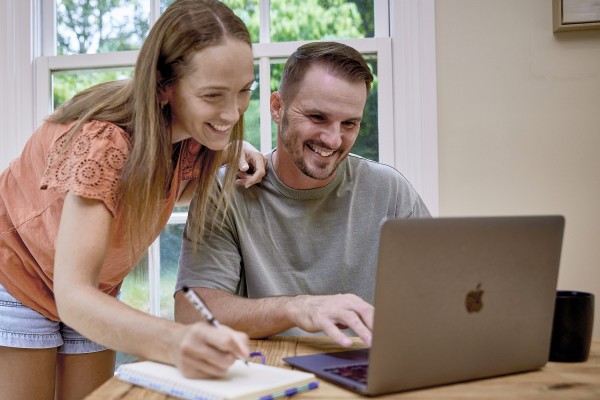Renting in Australia | What you need to know as a tenant

If you’re currently looking for a new home in Australia, you’ll know the rental market is something of a cut-throat business right now.
Good rental homes are being snapped up faster than you can get to the property inspection, and increased rental prices means a comfortable home doesn't come cheap.
And, once you’ve managed to find the right home for you and your family, you then need to interpret the rules, regulations and your tenancy rights in line with whatever state or territory you’re in. It’s a lot.
So we’re breaking down everything you need to know about renting in Australia and your rights as a tenant.
Let's dive in.
Rental process and documentation
Applying for a rental property can be a bit of a lengthy process. From application to approval through to all the paperwork and documentation - it’s easy to get bogged down by it all.
However, there are a few crucial things every tenant should examine thoroughly before signing on the dotted line.
The condition report, tenancy agreement and bond or security deposit agreement are crucial documents when it comes to protecting your rights.

Condition report
The condition report is a detailed review of the condition of the property before a tenant moves in. It covers everything within the home from the walls and carpets, through to every fixture and fitting.
Usually landlords and property managers will give you a number of days to check the condition report against the property. If there are any parts of the condition report you do not agree with, note them on the document accordingly before signing and submitting.
It’s vitally important to check the condition report before signing off on it. This is the only way to ensure that you are not liable for existing damages or issues that occurred outside of your tenancy.
Tenancy agreements
Residential tenancy agreements (or leases) are legally binding documents between the landlord and tenant. There are two main types of agreements: fixed term and periodic leases.
A fixed term residential tenancy agreement is for a set amount of time (often 6 or 12 months).
A periodic residential tenancy agreement (aka. months-to-month) has no end date and usually offers more flexibility for both tenant and landlord around ending the contract.
Look for the following essential information on your residential tenancy agreement:

Bond payments
Bond payments act as a security deposit for landlords in the event that a tenant breaks the agreements of the lease or causes damage to the property.
But, as a tenant there are a few rules and entitlements you should be aware of:
Maximum bond payments - by state and territory
A bond or security deposit is not legally required but is standard practice in most circumstances. The maximum amount that can be charged for your bond will vary a little depending on which Australian state or territory you are in.
Here’s a rundown:
Queensland
The Residential Tenancies Authority (RTA) says:
Victoria
Consumer Affairs Victoria states that in most cases a rental bond payment cannot be more than one month’s rent unless:
Western Australia
The WA Government states that bonds must not be more than four times the weekly rent unless the weekly rent is more than $1200 per week.
If there are pets living on the premises landlords may also charge a pet bond to a maximum amount of $260 (irrespective of the number of pets at the property).
South Australia
The Government in SA states that the maximum bond for a residential tenancy agreements in South Australia is:
Landlords must give tenants a receipt within 48 hours of receiving the bond.
New South Wales
Fair Trading NSW says a rental bond cannot be more than four weeks rent for rental agreements in New South Wales.
Northern Territory
NT Gov states that your landlord can ask you to pay a security deposit up to the maximum of four weeks rent in the Northern Territory.
Australian Capital Territory (ACT)
The ACT Revenue Office says rental bonds can be any amount, up to a maximum of four weeks rent in Australian Capital Territory.
Tasmania
Consumer Businesses and Occupational Services (CBOS) in Tasmania says a bond cannot be more than four weeks rent and cannot be increased during the tenancy.
Rental document checklist
Use this checklist to ensure you are provided with copies of all of the necessary documents pertaining to your rental agreement.

For tips on getting your bond back when it's time to leave your rental, see our moving out guide for renters.
Rental rights in Australia - national, state and territory
During your time living in your new rental home, you may encounter issues that need addressing.
Common issues include:
Once again, laws and rental rights on these issues can differ a little from state to state so it’s always best to double check with the appropriate government department or body.
Rent increases
If you are on a fixed term agreement of two years or less, the landlord should not request a rental increase unless it’s been written into your tenancy agreement.
However, as soon as your agreement term has come to an end, you’ll likely move onto a periodic agreement where the rent can be increased. There are limits as to how much rent can be increased (usually only once every 6 - 12 months) but this will vary a little depending on which state or territory you are in.
83% of Australian renters have no fixed-term lease or are on a lease 12 months long or less. 20% of renters are on a month-to-month ‘rolling’ lease, according to Tenants Queensland.”
The best course of action is to keep track of when your fixed term is due to end and negotiate a new contract to commence as soon as it’s over.
Whenever rent is increased you are entitled to a notice period. This is usually 60 days although it is less in certain states or territories.
Repairs and maintenance

If you are living in a rental property, chances are, property repairs or maintenance will be required from time to time.
As the tenant it is deemed your responsibility to promptly report any repairs or maintenance to the lessor, agent or provider. Unfortunately, many tenants fail to report out of fear of rent increases.
62% of tenants say they feel like they can’t ask for changes
Typically once you report a repairs or maintenance issue the problem will be classified as either urgent and emergency or non-urgent.
Urgent repairs include issues that pose a risk or create a high level of inconvenience for the tenant. Examples include:
Non urgent or routine repairs or maintenance cover most other issues and include things like minor issues with toilets, baths or sinks, plaster repairs, paintwork, brickwork, and other internal and external works.
While there is a general expectation that non-urgent / routine repairs are carried out within a fair and reasonable time, this isn’t always the case.
If you find yourself in a situation where necessary repairs have not been carried out within a fair and reasonable time you must still continue to pay your rent but may be entitled to request a rent decrease.
To request a rent decrease, contact your lessor, agent or provider to negotiate.
Property inspections
Routine inspections may be carried out from time to time either by the real estate manager or the landlord. The aim is to ensure the property is well cared for by the tenant and to check for any repair, maintenance or health and safety issues.

A landlord / real estate must provide notice if they intend to conduct an inspection:
QLD: Routine inspections cannot be carried out more than once every 3 months (unless the tenant agrees in writing). The tenant must be given a minimum of 7 days' notice for entry, using an Entry notice (Form 9).
NT: Inspections can be carried out a maximum of once every 3 months. This period can be longer if the tenant and landlord agree to it in the tenancy agreement. Entry for a regular inspection must be made between 7am and 9pm. The landlord must arrange an inspection time with the tenant at least 7 days in advance.
VIC: 7 days notice is required.
SA: Tenants must be notified before a landlord or someone authorised by them enters a rental property. This includes entry to gardens, sheds or yards. Most of the time, the landlord must enter during ‘normal hours’ – between 8.00 am and 8.00 pm any day other than a Sunday or public holiday
NSW: At least 7 days' written notice required with inspections allowed up to 4 times in a 12 month period.
TAS: Routine inspections can be carried out every three months, but the landlord must provide 24 hours notice
Making changes to the property
Typically a tenant can only attach a fixture, or make a structural change to a rental property if the property manager/owner agrees.
Requests for approval should always be made in writing with all the details of the change and whether the fixture will be removed at the end of the tenancy.
How much can a landlord increase rent in Australia?
Rent increases are completely legal, and are in fact quite standard when you come to the end of your fixed agreement term. However, landlords must follow rent increase laws. These are a little different in each state and territory.
NSW: Landlords must provide a written notice of the rental increase 60 days before the rent is raised.
VIC: Landlords in Victoria must provide written notice of any rent increase at least 60 days prior.
QLD: Landlords must notify tenants of any property rent increases at least two months before it is implemented.
TAS: 60 days notice must be provided and rent can only be increased a minimum 12 months after the last increase.
NT: 30 days of written notice are required for any rental increases and rent can only be increased a minimum six months after the tenancy started or at least six months from the last increase.
ACT: Landlords must provide eight-weeks notice to tenants for rent increases. Generally, landlords may only increase rent by 10% over the increase in Canberra CPI.
SA: 60 days notice must be provided and rent can only be increased every six months for leases starting before March 2014 or every 12 months for leases starting after March 2014. There are no limits to rent increase prices.
WA: Landlords must provide a written notice (via form WA Department of Commerce-approved) 60 days before the increased rent is implemented.
Bills and utilities - who pays, landlord or tenant?

To cut down on expenses, here’s a handy read on how to reduce your power bill.
Eviction - your rights as a tenant
One rule that stands strong across every state and territory is that a landlord cannot evict you when you’re on a fixed term agreement unless they have a good cause.
This is generally only applicable if the tenant has violated their tenancy agreement.
However, if you are on a periodic lease, it’s a slightly different story.
Technically, a landlord can ask you to leave with ‘no grounds’ as long as it is within the agreed notification period - sometimes as little as 30 days.
Finding reliable removalists
Once you’ve secured your new home, planning your move is simple with Upmove. All our removalists are vetted and verified, so you know your belongings are in good hands.
With just one request, you’ll get multiple quotes to compare and choose what works best for you. Make your move hassle-free — book affordable removalists and relocate with less stress.

What do our customers say?




























